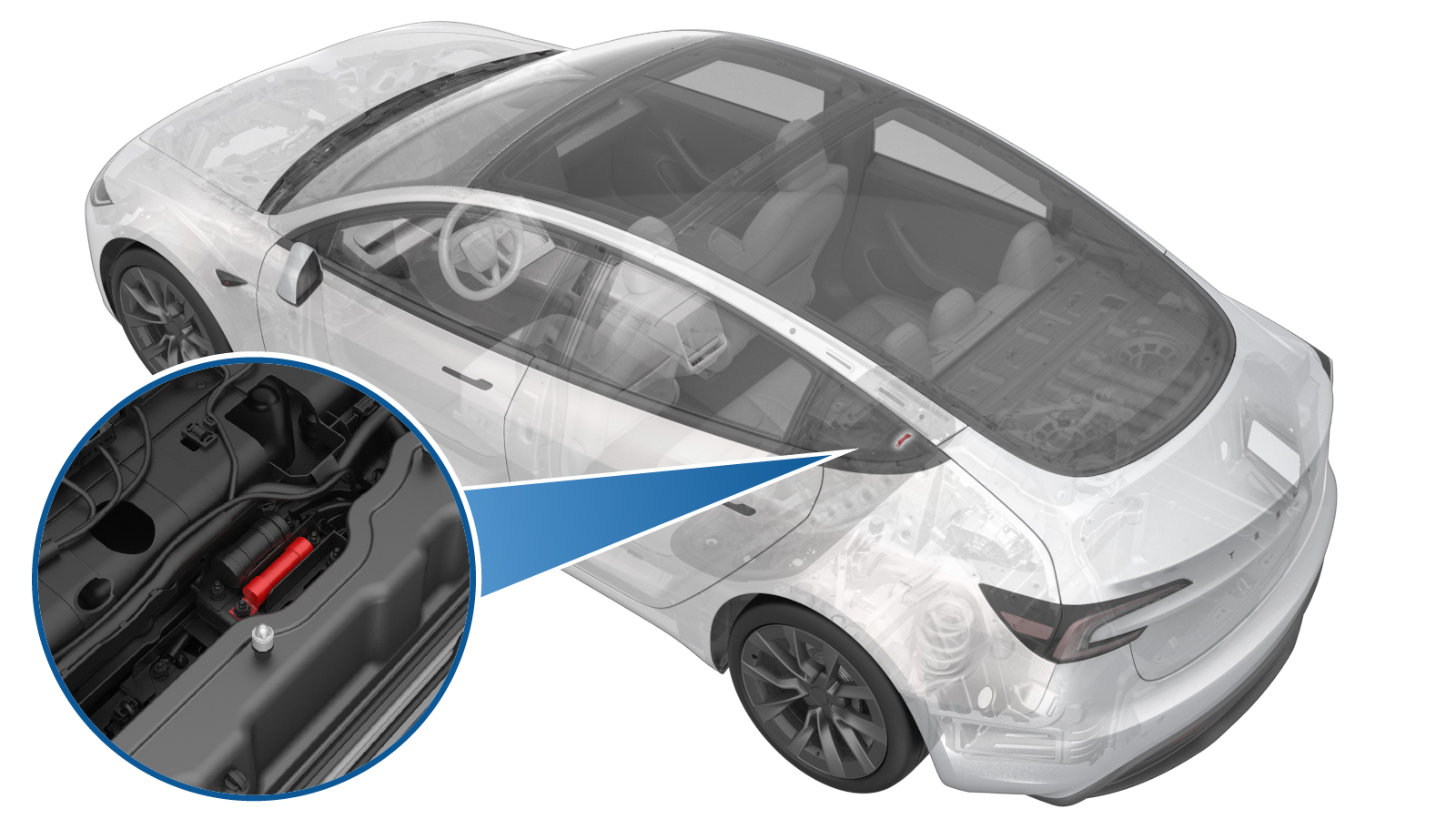Fuse - A/C Compressor - HV Battery (Remove and Replace)
 Correction code
1630010302
FRT
0.90
NOTE: Unless
otherwise explicitly stated in the procedure, the above correction code and
FRT reflect all of the work required to perform this procedure, including
the linked procedures. Do
not stack correction codes unless explicitly told to do so.
NOTE: See Flat Rate
Times to learn more about FRTs and how
they are created. To provide feedback on FRT values, email ServiceManualFeedback@tesla.com.
NOTE: See Personal Protection
to make sure wearing proper PPE when performing the below procedure.
NOTE: See Ergonomic Precautions for safe and
healthy working practices.
Correction code
1630010302
FRT
0.90
NOTE: Unless
otherwise explicitly stated in the procedure, the above correction code and
FRT reflect all of the work required to perform this procedure, including
the linked procedures. Do
not stack correction codes unless explicitly told to do so.
NOTE: See Flat Rate
Times to learn more about FRTs and how
they are created. To provide feedback on FRT values, email ServiceManualFeedback@tesla.com.
NOTE: See Personal Protection
to make sure wearing proper PPE when performing the below procedure.
NOTE: See Ergonomic Precautions for safe and
healthy working practices.
- 1057602-00-A Ratchet, 1/4" Sq Dr, HV Insulated
- 1057604-00-A Skt, 1/4" Sq Dr, 8mm, HV Insulated
- 1057606-00-A Skt, 1/4" Sq Dr, 13mm, HV Insulated
- 1131071-00-A Dummy Disconnect, Pyro, Safety
- 1108272-00-B Cap, Logic Conn, Inv, 3DU
- 1076927-00-A Resistance meter, microohm, Hioki RM 3548
- 1076927-00-A Resistance meter, microohm, Hioki RM 3548
Only
technicians who have completed all required certification courses are permitted to
perform this procedure. Tesla recommends third party service provider technicians
undergo equivalent training before performing this procedure. For more information on
Tesla Technician requirements, or descriptions of the subject matter for third parties,
see HV Certification Requirements. Proper personal protective equipment (PPE) and insulating HV
gloves with a minimum rating of class 0 (1000V) must
be worn at all times a high voltage cable, busbar, or fitting is handled. Refer to Tech Note TN-15-92-003, High Voltage Awareness
Care Points
for additional safety
information.
Torque Specifications
| Description | Torque Value | Recommended Tools | Reuse/Replace | Notes |
|---|---|---|---|---|
| Nuts (x2) that attach the A/C compressor fuse to the ancillary bay bus |
 2.5 Nm (1.8 lbs-ft) |
|
Replace |
Remove
-
Remove the ancillary bay cover. See Ancillary Bay Cover (Remove and Replace).
WarningHV insulating gloves and leather glove protectors must be worn throughout the remainder of this procedure. Do not remove gloves or protectors until otherwise noted.
- Remove the pyrotechnic battery disconnect. See Pyro Disconnect - HV Battery (Remove and Replace).
-
Remove and discard the nuts
(x2) that attach the A/C compressor fuse to the ancillary bay bus, and then
remove the fuse.
TIpUse of the following tool(s) is recommended:
- Insulated
tools:
- 8 mm socket
- Ratchet/torque wrench
WarningThe video(s) included in this procedure are meant as an overview for supplemental purposes only. Follow all of the steps listed in the procedure to avoid damage to components and/or personal injury. - Insulated
tools:
Install
-
Perform a zero adjust of the
Hioki resistance meter in preparation to measure resistances later in this
procedure.
WarningHV insulating gloves and leather glove protectors must be worn throughout the remainder of this procedure. Do not remove gloves or protectors until otherwise noted.
-
Install the A/C compressor
fuse to the ancillary bay bus, and then install new nuts (x2) to attach the fuse
to the bus.
 2.5 Nm (1.8 lbs-ft)TIpUse of the following tool(s) is recommended:
2.5 Nm (1.8 lbs-ft)TIpUse of the following tool(s) is recommended:- Insulated
tools:
- 8 mm socket
- Ratchet/torque wrench
- Insulated
tools:
-
Use the Hioki resistance
meter to measure the resistance at the HV joint of the A/C compressor fuse
and the positive DC busbar.
CAUTIONDo not short the side of the probe tip to the edge of the fuse lug.NoteThe maximum acceptable resistance is 0.145 mΩ (145 μΩ). There is too much resistance in the High Voltage joint. Remove the fastener, clean areas with isopropyl alcohol, install fastener back and test again
-
Use the Hioki resistance
meter to measure the resistance at the HV joint of the A/C compressor fuse
and the electrical harness terminal.
CAUTIONDo not short the side of the probe tip to the edge of the nut's captive washer.NoteThe maximum acceptable resistance is 0.105 mΩ (105 μΩ). There is too much resistance in the High Voltage joint. Remove the fastener, clean areas with isopropyl alcohol, install fastener back and test again
- Measure the voltage across the pyrotechninc battery disconnect mount points, and then install the pyrotechnic battery disconnect. See Pyro Disconnect - HV Battery (Remove and Replace).
-
Install the ancillary bay cover. See Ancillary Bay Cover (Remove and Replace).
NoteBefore installing the ancillary bay cover, inspect the ancillary bay cover seal and confirm there is no visual damage. If the seal is torn and/or delaminated, replace the ancillary bay cover.